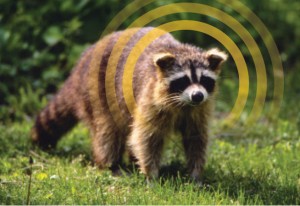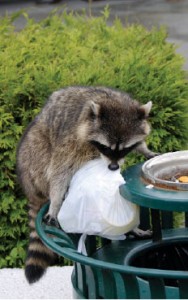At Animal Doctor, we regularly trap and remove raccoons at residential and commercial locations. We recommend the homeowner, or facility manager at a commercial site to stay clear of doing this work themselves. Raccoons are aggressive and will attack humans. They also can damage a structure significantly.
While hardware stores sell raccoon traps to consumers, this isn’t a job for a novice because the most frequently reported animal species with rabies in the U.S. is the raccoon. It’s also recommended anyone performing raccoon work be immunized for rabies, which can be passed through their saliva, scratches and bites. Homeowners who’ve attempted to trap raccoons — or nontarget animals such as skunks — will eventually call us to remove or finish the job.
When we first began trapping raccoons years ago, we’d place pieces of raw chicken in the trap as bait. Although we quickly learned this practice also attracted flies and other insects, the only time we ever trapped two raccoons in one cage at the same time was when we used raw chicken as bait. Currently, we only purchase baits sold by companies that specialize in targeted animals such as raccoons. In certain instances, Animal Doctor has used a snare pole — a long tool with a noose on one end — to remove a live raccoon. This doesn’t harm raccoons, and it enables prompt removal.
Trapping basics
Selecting the right size trap is key. For example, a squirrel trap shouldn’t be used to catch raccoons and vice versa. A supplier can assist you if you’re beginning. Also, traps should be labeled with your company name, address and phone number, which should be tied into an emergency company phone number so raccoons can be picked up at off-hours and weekends.
Traps should be checked at least once a day. In inclimate weather, they should be checked every eight hours. In extreme heat or cold, suspend trapping until the weather is temperate. We ask clients to monitor the traps throughout the day. If you plan to implement daily trap checks, you’ll need to have a 24-hour emergency response system in place.
Determine your company policy about what to do with a trapped raccoon. Some companies trap and remove the animal themselves; others euthanize them. Comply with the regulations in your state or county. Compliance is key.
Whether you’re a beginner or a pro at wildlife control trapping, network with and benchmark yourself against other pest management and nuisance-wildlife companies. Attend the annual Wildlife Expo put on by the National Pest Management Association (NPMA) and the National Wildlife Control Operators of America (NWCOA). The NPMA Wildlife Committee also meets throughout the year. These are ideal ways to keep in touch with your peers about industry trends.
[ RELATED LINKS: Raccoon Fast Facts | A Funny Raccoon Story ]
Prevention first
Raccoon tips we pass on to customers are:
- Keep trash can and Dumpster lids secured and garage doors shut because raccoons often forage for their next meal in these spots. Raccoons are creatures of habit. Once they find food, they’ll return repeatedly.
- Raccoons are smart and strong. They can rip siding off a house, remove exterior vents and pull down sections of soffits on homes, enabling them to enter a structure. Based on the extensive damage raccoons are known to cause, offering a handyman/contractor or repair division is a nice add-on business. If it’s a small opening, we provide the exclusion ourselves. If the client wants the work to be more aesthetically pleasing, we recommend a contractor.
- Reporting for latrine duty. Another facet to the raccoon business is cleaning, disinfecting and removing raccoon droppings in an attic or crawlspace. Raccoons create a latrine, or area where they deposit their feces regularly. Because raccoons can carry disease, encourage clients to have these areas cleaned and disinfected. Raccoon roundworm, for example, is a microscopic parasite that can cause blindness and death in humans. When technicians perform this type of work, they should wear proper personal protective equipment (PPE) because it’s considered hazardous waste. A full-face respirator with high-efficiency particulate air (HEPA) filters, Tyvek uniform and neoprene rubber gloves are necessities for the job.
Raccoon removal and trapping is a much-needed service. Because raccoon remediation can be involved, encourage clients to have a professional nuisance wildlife control operator handle this work. If your company doesn’t do this type of work, find a reputable company willing to be a subcontractor for you. pmp
Aust is president and CEO of Bird Doctor Nationwide and can be reached at stuart@birddoctorinc.com.


Leave A Comment